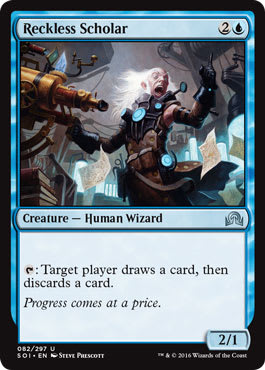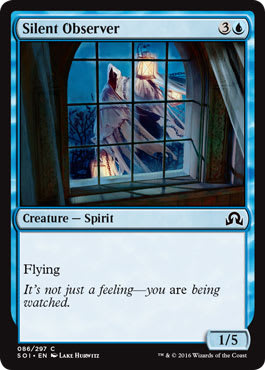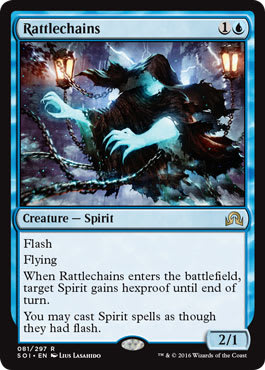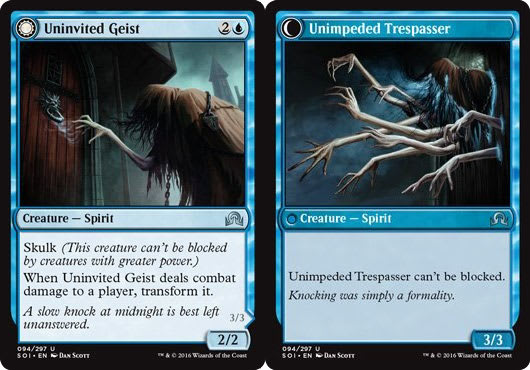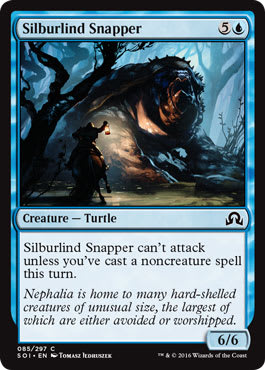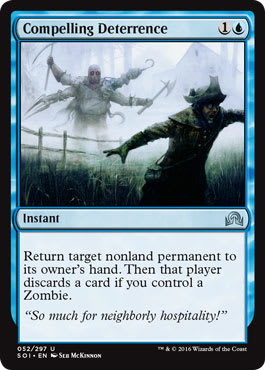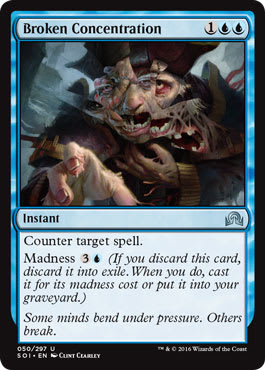As anyone who’s ever spent Summers visiting scenic Nephalia will tell you, their beaches are not exactly one of Innistrad’s prime tourist destinations. At first you’d think so, since the sand of Nephalia’s beaches is mixed with a sort of granular silver, giving them an exotic, shimmery look during the day and a reflective glow when the moon is strong in the sky.
But if the beaches themselves are pleasing to a reveler’s eye, the region’s craggy coastline is conversely an unsettling sight to a mariner’s. Many the skiff or vessel has floundered in the shoals or broken up upon the rocks. Over time, too many of Nephalia’s men and women have become widows and widowers, their loved ones lost at sea.
And too often, those who have met an untimely end haven’t found the Blessed Sleep they’d hoped for. The Nephalian coast is infested with the geists of the dead, and, as the tide rolls in, the Nebelgast rolls with it. This briny fog brings more than obscured vision and a chilling damp, as the shipwrecked undead follow the mist toward civilization.
Don’t go into the mists, you might well be warned by a Nephalian native. What they might not tell you is sometimes, the mists come for you.
Or with today’s deck, they come for your opponent.
In today’s Meddling we’ll be looking at Ghostly Tide, the U/W Spirits-themed Skies deck from Shadows over Innistrad. As we do in our Meddling series, we look to tear the deck down and rebuild it, reinforcing the deck’s themes with tighter card selection. Of course, we’ll be adhering to the Two Rules of Meddling.
Rule #1:
No added rares or mythics. To keep the deck affordable, the only rares we’ll use are the two already in the deck. For the rest of the deck, we’ll be pulling from commons and uncommons only.
Rule #2:
Only use sets represented in the deck. Since the only set in this deck is Shadows over Innistrad, that’s the only set we can draw from. This helps make the deck accessible — especially for folks new or returning to the game who might not have a stockpile of older cards to pull from.
With those ground rules in place, let’s brave the Nebelgast and see if we can’t enlist some ghostly allies for our battles! Before we tune, let’s start with a look at the stock deck list.
Ghostly Tide (Stock Deck) ? Shadows over Innistrad Standard | Wizards of the Coast
- Creatures (20)
- 1 Drogskol Cavalry
- 1 Rattlechains
- 1 Reckless Scholar
- 1 Silent Observer
- 2 Apothecary Geist
- 2 Dauntless Cathar
- 2 Emissary of the Sleepless
- 2 Nearheath Chaplain
- 2 Niblis of Dusk
- 2 Seagraf Skaab
- 2 Spectral Shepherd
- 2 Stormrider Spirit
- Spells (15)
- 1 Catalog
- 1 Deny Existence
- 1 Essence Flux
- 1 Silverstrike
- 2 Puncturing Light
- 1 Chaplain's Blessing
- 1 Pore Over the Pages
- 2 Not Forgotten
- 1 Sleep Paralysis
- 2 Bound by Moonsilver
- 2 Vessel of Ephemera
The Exorcism
We’ll begin by driving out those Spirits and other who aren’t doing enough for the deck. The first to fall here is the Seagraf Skaab, a 2-mana 1/3. This guy is never going to clinch any games for you. Rather, the purpose of cards like this is to congest the red zone, to thicken up the attack lanes and blunt your opponent’s offensives. The inclusion of cards like this is a sure sign of a deck which is happy to trade speed for power.
This can often be a more difficult proposition for our level of construction. When you’re limited to a card pool without some of the most powerful cards in the set (mythics and rares), you can overcome some of the power shortfall by working with speed. It’s not for nothing many aggressive Red decks operate just fine with a slew of solid commons/uncommons. It doesn’t really matter if your opponent runs a deck filled with splashy rares and mythics if they’re dead before they can draw more than a few of them. Speed is a great leveler, but it doesn’t mean we can’t do some good things with a slower build.
But a 1/3 roadblock won’t be necessary.
We’re also reassigning the Dauntless Cathar to another watch. There’s a deck out there that’s happy with a 3-mana two-toughness groundling capable of waking a Spirit from the Blessed Sleep, but we’re going to be looking for more aerial presence in our finished product.
The Reckless Scholar is a nice bit of card filtering, and stronger still in decks which use a lot of Madness cards, since it can turn the discard into further advantage. However, we’re looking for consistency more than just occasionally clever play, so we’ll send him on his way. He can take the Apothecary Geist with him. Though, the spook raiding the medicine cabinet is the right tribe, a 4-mana 2/3 flier is weaker than we’d want. We also don’t want synergy just for the sake of synergy. The three life we’d get off of running the Apothecary Geist doesn’t make up for it not a very good card.
Like the Dauntless Cathar, we’re also going to pass on the Nearheath Chaplain. There’re a few reasons to recommend this card, even at the price of four mana. It’s a three-power roadblock, which means it can take down decent-sized attackers by trading. We actually achieve virtual card advantage with it, since the Chaplain can then be used to summon a pair of 1/1 Spirits. The life gain is a nice bonus, typically a hedge against more aggressive decks. And it even synergizes well with the deck’s premium rare, Drogskol Cavalry.
So what’s the problem? Mainly, it’s a matter of space. As you’ll see, we’re going to want to have a larger than usual number of non-creature spells in the finished deck, which means we have to wield a wicked scalpel. Rather than using creatures to blunt our opponent’s offense while we look to construct our own, we’ll be using spells to do it instead.
With that in mind, it should be clear the Silent Observer needs to go watch somewhere else. A flying 1/5 doesn’t pack nearly enough punch. That also goes for theEmissary of the Sleepless. In this deck, killing creatures won’t be as common an event as a more ground-based strategy. Indeed, we’re looking to avoid creature entanglements by keeping ours flying high above the battlefield. As a result, the conditional trigger giving us the extra 1/1 Spirit off of the Emissary just isn’t reliable enough. You don’t want to be in the position of holding off on casting the card for fear of not getting maximum value, when the correct play ends up being to cast it as soon as you can.
The final creature cut here is the Stormrider Spirit. Weighing in as a 3/3, it’s certainly one of the more robust Sprits in the deck, and Flash can be used like ersatz removal to pick off a defender who thought the coast was clear. But we’re going to want to use the end of our mana curve for a closer or two, especially since the Drogskol Cavalry costs seven mana.
Summon the Spirits
Now we’ve made our round of cuts, so it’s time to see what’s left and fill in the vacancies.
First up is the Rattlechains, the deck’s second rare card. Cheap in cost but aggressively-statted, Rattlechains does a ton of work for this deck. It can be used as an ersatz Counterspell, thwarting an opponent’s attempt to pick off one of your creatures with removal. And once it’s in play, you can cast all of your Spirits at Instant speed.
Next up is the Niblis of Dusk. Since we’re going to be using a higher number of Instants and Sorceries, the Prowess on the Niblis will help get in some extra damage. It has the right stats, too, balanced in favor of power over toughness. It’s a solid card, and we’ll go up to four.
The Spectral Shepherd is another we’ll keep. It’s a 3-drop 2/2 with the evasion we’re focusing on, and it also has a nice little activated ability which serves as a bolt hole for our Spirits. Since we’re running a leaner selection of creatures in our build, this means each one is a little bit more important. Being able to yank one back to the safety of the hand in response will disrupt our opponent’s effectiveness with pinpoint removal or combat tricks. Since they know we can just pull a target back in response (even if we have to recast it), they may try and hold on to removal until we’re tapped out. If this can interrupt their pace of play, then so much the better for us.
The next card is not included in the stock deck list, the Uninvited Geist. This is a double-faced card (DFC) which begins as a difficult-to-block 2/2 creature. We need only connect with our opponent once to transform it into a 3/3 unblockable creature that can freely hammer into our opponent for the rest of the game. Thanks to Skulk, this Geist can pose some challenge for your opponent to block, and if you’ve managed to play your Rattlechains, you can even bring it in at the end of your opponent’s turn for some extra surprise factor.
We’ll be grabbing another DFC for our next card. Those who played during the original Innistrad will remember the Delver of Secrets, which made a big impact in Constructed play of the time. This time around, we get to see the next chapter in that story with the Aberrant Researcher, a perfectly-reasonable 3/2 flier. Since we’re going for a spell-heavy deck, you’ll have a good chance to trigger the Researcher’s transform condition, which gives you a very substantial five-power evasive closer.
Finally, we’ll go with one last addition which plays into the “spells matter” theme of the deck, the ultra-efficient Silburlind Snapper. You don’t see a lot of Blue, 6-mana 6/6’s in Magic which don’t have an attacking restriction of some kind (unless they’re rare or mythic), but a creature of that size doesn’t always have to attack to help you win. If your opponent is running smaller groundling creatures, the Snapper can shore up the back-end by being a nasty blocker, while you finish off your opponent in the air. We’ll take two.
The last card here is the Drogskol Cavalry, our premium rare. The Cavalry is silly expensive, being seven mana for a 4/4 flyer (compare to Serra Angel, without her Vigilance). But the Cavalry is also a one-card combo. With the Cavalry in play, any time a Spirit enters the battlefield, you gain two life. And guess what? It also lets you repeatedly spawn more Spirits! I’m not a big fan of life gain under most circumstances, but if we want a couple ways to stumble an opponent’s offensive, you could do worse than being able to crank out chump blockers and gain a little life while our air force does its job.
Now for the Spells
The deck we’re building today places a higher emphasis on non-creature support cards, particularly Instants and Sorceries. This gives the deck a bit more of a control feel, which you’d expect for a U/W Skies build. Because most of our creatures are evasive, we don’t need to go toe to toe on the ground with our opponent’s army. Instead, we can do more with less by letting them carve up our opponent in the air, while we mitigate the incoming damage on the ground through removal and permission.
This means that most of the non-creature cards in the stock Intro Pack deck list need to go. We don’t want random effects like simple life gain through Chaplain's Blessing, and we won’t have the heavy Madness focus which makes cards like Pore over the Pages and Catalog punch above their weight.
Instead, we want to focus in on the least number of spells, and include the most copies. This gives us a much more reliable output. Since we need removal to keep our opponent’s worst creatures under control, we need to make sure to maximize our chances of drawing it when we need it. The singleton, random design philosophy of the Intro Pack decks needs to be streamlined.
Since we’re effectively ceding the ground game to our opponent, we’re going to want to make sure we have abundant removal. That’s going to let you continually prune back their offensive, keeping it at a manageable level while you race in the skies. We’ll start with a play-set of Puncturing Light, a cheap Instant that can kill off an attacker (or blocker, if they happen to mount an air defense). There is a size restriction on the card, being ineffective against anything with a power four or greater, but you’ll seldom want for targets.
In the event your opponent does manage to field larger threats, you’ll want to be able to manage those as well. That’s why we’re going to pack in a play-set of Silverstrikes. Silverstrikes can only answer an attacker, but it also gives us a little bit of life. Again, we won’t want to focus on life gain, but it’s welcome as a free rider here.
With eight pieces of reactive removal, your opponent should be a little anxious whenever going on the attack. In the event they’re able to mount a reasonable aerial defense, we’re going to add in a pair of Bound by Moonsilvers. These are essentially Pacifisms you can move around as needed. The cost of doing so is steep — even sacrificing a land may set back your ability to play your top-of-curve cards — but having the option is always welcome.
Next up is a trio of Compelling Deterrences. One of the two 2-mana Unsummon variants available to us, this one is the better of the pair for our purposes. The other — Just the Wind — hits less targets in exchange for having Madness, and we aren’t using Madness. We won’t necessarily be getting full value out of Compelling Deterrence, since we’re crafting a Spirits deck over a Zombie one, but since we’re already heavily invested in Instants and Sorceries, we’re also going to include a miser’s copy of Rise from the Tides. This has the option of giving us a horde of 2/2 Zombie tokens, which can both further clog things up on the ground as well as potentially help us overwhelm an opponent for an alpha-strike if the numbers are in our favor. That also will maximize the effect of Compelling Deterrence, forcing an opponent to discard a card in addition to the bounce.
Finally, just to make sure things flow the way we’d like them to, we’re going to round the deck out with a play-set of Broken Concentration. Ignore the Madness cost on these since they’re essentially a Cancel, which is perfectly playable in this environment. This dose of permission serves two purposes. First and most obviously, it can stop any kind of threat your opponent might have dead in its tracks. Use it to get rid of a creature, protect yours, or just ensure momentum remains on your side.
The other effect is when your opponent knows you’re playing with permission. This can disrupt their own play, hesitating to play a card they feel is particularly crucial while you have the mana up for counter magic. They may delay a turn, wait for you to be tapped out, or even try to play an inferior card first to try and “bait out” your counter. Anything which gets your opponent mentally away from playing their game and more worried about yours can only help. Having four here is just enough to keep them guessing.
And that’s a wrap! We’ve got a U/W Skies deck with a heavy Spirit focus and some tribal synergies, which invites aggression from an opponent on the ground while attacking with difficult-to-block creatures. With plenty of removal and a permission suite, it has a solid control element offering additional security once you’re in the driver’s seat of the game.
Conclusion
In reviewing the Shadows over Innistrad Intro Pack decks, last week’s Angelic Fury was clearly the worst, but I wasn’t especially impressed by Ghostly Tide, either. But with a solid theme to work with, this build should be a lot more fun to play. Happy haunting!
Meddled Ghostly Tide ? Shadows over Innistrad Standard | Jay Kirkman
- Creatures (18)
- 1 Drogskol Cavalry
- 1 Rattlechains
- 2 Silburlind Snapper
- 2 Spectral Shepherd
- 4 Aberrant Researcher
- 4 Niblis of Dusk
- 4 Uninvited Geist
- Spells (18)
- 3 Compelling Deterrence
- 4 Broken Concentration
- 4 Puncturing Light
- 4 Silverstrike
- 1 Rise from the Tides
- 2 Bound by Moonsilver
















